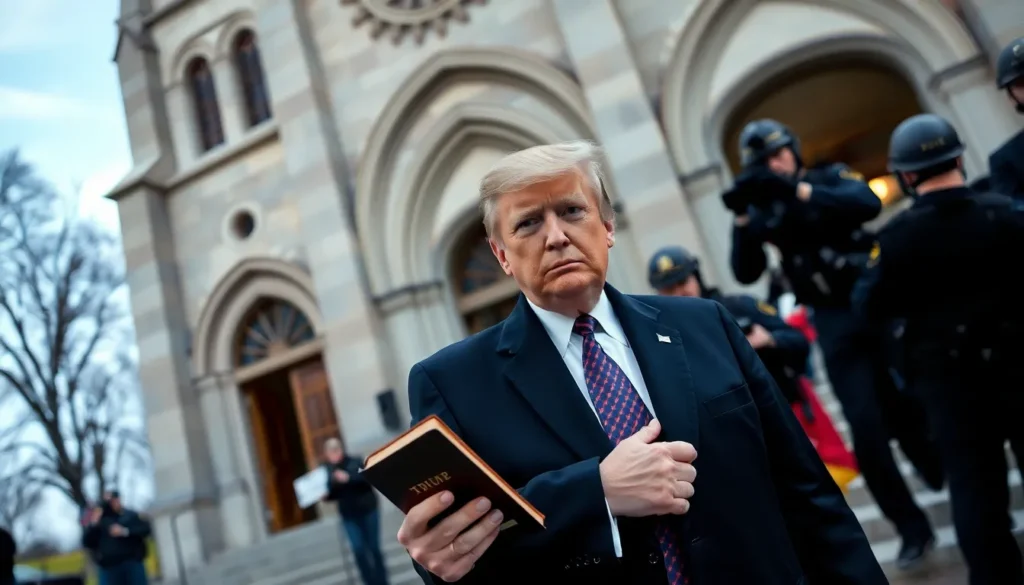Table of Contents
ToggleIn a moment that sparked widespread discussion, former President Donald Trump famously held a Bible aloft outside St. John’s Church during protests in June 2020. However, the image of him clutching the sacred text raised eyebrows, particularly as he didn’t place his hand on it in a traditional gesture of reverence. This unusual choice led many to question the significance of the Bible in his public persona and its role in American politics.
The incident reflects a broader conversation about faith, symbolism, and authenticity in leadership. For some, it exemplified a disconnect between Trump’s actions and the values he claimed to uphold. As the nation grapples with its complex relationship with religion and politics, this moment serves as a poignant reminder of how gestures can shape perceptions and provoke intense debate.
Overview of the Event
The event in question occurred on June 1, 2020, when former President Donald Trump posed with a Bible outside St. John’s Church in Washington, D.C. This moment happened amidst nationwide protests against systemic racism and police violence. Trump’s decision to raise the Bible sparked immediate controversy, as many interpreted it as a political ploy rather than a genuine expression of faith.
The situation escalated when law enforcement forcibly cleared protestors from Lafayette Square to facilitate Trump’s photo opportunity. Critics pointed out the dissonance between his actions—using a sacred text during a moment of civil unrest—and the values commonly associated with religious leaders. Analysts noted that such symbolic gestures could influence public perception significantly, potentially causing harm to the trust between leaders and the communities they serve.
The Bible itself, a potent symbol in American culture, became a focal point in discussions about authenticity in political leadership. Observers questioned whether Trump’s handling of the text aligned with genuine Christian values or represented a superficial display aiming to generate support from evangelical voters. This event exemplified the ongoing intersection of religion and politics in the U.S., highlighting the complexities and potential consequences of public acts of faith.
Context of “Trump No Hand on Bible”

The moment when former President Donald Trump held a Bible outside St. John’s Church in June 2020 serves as a critical touchpoint for examining the interplay of religion and politics in America. This incident, occurring amid widespread protests, raises vital questions about authenticity and representation in leadership.
Historical Significance
The act of holding a Bible has deep historical roots in American political culture. From early presidential inaugurations that featured biblical oaths to public figures invoking religious texts for legitimacy, the Bible symbolizes moral authority. Trump’s gesture, however, drew criticism. Many argued it lacked the solemnity traditionally associated with religious practices, particularly given the context of forcibly clearing protestors. Scholars highlight how this disconnect from historical norms can impair public trust in leaders, as it may present a politicized rather than a sincere use of religious symbolism.
Cultural Impact
Trump’s Bible photo op sparked widespread debate across cultural and social landscapes, influencing various demographics differently. For many evangelical voters, Trump’s actions seemed to reinforce their beliefs, while others perceived the gesture as a manipulative attempt to co-opt Christianity for political gain. The resulting discourse illuminated a divide between those who view the Bible as a sacred text and those who consider it a tool for political manipulation. This moment also intensified nationwide discussions about the role of religion in politics, prompting both support and backlash within different communities, demonstrating the ongoing relevance of religious symbols in contemporary political narratives.
Reactions and Controversies
Reactions to Trump’s Bible photo op included a mix of political backlash and public scrutiny. Analysts and commentators highlighted the implications of using religious symbolism in a politically charged atmosphere.
Political Reactions
Political leaders from both parties denounced Trump’s actions. Democrats criticized the photo op as a manipulation of faith for political gain, expressing concern over its lack of authenticity. Some Republican figures defended Trump’s gesture, arguing it represented a reaffirmation of faith amid social unrest. A notable faction within the evangelical community supported him, believing it aligned with their values. Congressional debates emerged, reflecting a divided perspective on religion’s role in politics, further complicating the national conversation. The incident ignited discussions about the responsibilities of political leaders when invoking religious symbols, prompting calls for more respectful engagement with faith.
Public Opinions
Public opinions varied widely after the incident. Some Americans expressed approval of Trump’s display, viewing it as a strong endorsement of Christian values during turbulent times. Conversely, many citizens perceived the action as a superficial political maneuver, questioning its sincerity. Polls indicated a significant split; a majority of evangelical respondents felt a connection to Trump’s image, while others distanced themselves from the act, citing a lack of genuine reverence. Social media reactions amplified the controversy, with hashtags trending that either supported or criticized the president’s actions. The divergence in public sentiment underscored ongoing debates about the intersection of faith and politics, revealing deep societal divides over the meaning and use of religious symbols in the public sphere.
Media Coverage
Media coverage of Trump’s Bible photo op revealed a complex landscape of reactions across news outlets and social media platforms. Major national news networks dedicated extensive segments to the incident, analyzing its implications within the broader context of social unrest and political strategy. Reports frequently highlighted the contrasting perspectives on the significance of the gesture, emphasizing the divide among viewers and commentators.
Print media provided in-depth analyses, with op-eds from various political analysts and religious figures criticizing Trump’s actions as a politicization of faith. Prominent articles questioned the authenticity behind the gesture, framing it as an attempt to court evangelical voters during a pivotal moment in American politics. In contrast, conservative commentators defended the act as a legitimate expression of faith, promoting it as a necessary response to the rising social tensions.
Social media platforms became hotspots for public discourse surrounding the event. Twitter and Facebook witnessed a surge in posts, both supporting and condemning Trump’s actions. Hashtags related to the incident trended rapidly, amplifying the split reaction among the electorate and political commentators. Many users expressed their views, contributing to a national conversation regarding the relationship between religion and politics in the United States.
Poll results following the incident indicated that opinions on Trump’s gesture varied widely. A considerable portion of respondents expressed disapproval, perceiving the act as disingenuous. Conversely, a significant segment of evangelical voters viewed the photo op positively, believing it reaffirmed their religious values amidst societal turmoil. These contrasting beliefs showcased the ongoing divide within the American populace.
News coverage consistently addressed the historical context of religious symbolism in politics, referencing past leaders who invoked faith to connect with the public. Analysts noted that Trump’s handling of the Bible lacked the customary reverence associated with such displays, raising concerns about the future implications for American political culture. The discourse surrounding this event emphasized the influential role of media in shaping public perception and its capacity to facilitate dialogue on critical socio-political issues.
The moment Trump held the Bible outside St. John’s Church remains a pivotal point in American political discourse. It encapsulates the complex relationship between faith and politics and raises critical questions about authenticity in leadership. The varied public reactions underscore deep societal divides regarding the interpretation of religious symbols in the political arena.
As discussions continue to evolve around this incident, its implications for trust in political leaders and the role of religion in public life will likely persist. The incident serves as a reminder of the power of symbolism and the potential consequences when it intersects with political maneuvering. Ultimately, the legacy of Trump’s Bible photo op may influence future political strategies and the relationship between faith and governance in America.







